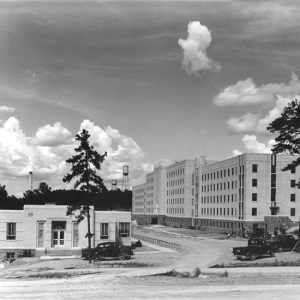calsfoundation@cals.org
Tuberculosis
Tuberculosis (also known as consumption) is a contagious, potentially fatal bacterial infection that mainly affects the lungs. It is caused by the tubercle bacillus (Mycobacterium tuberculosis), which was discovered by Robert Koch in 1882. By 1900, the disease was the second-leading cause of death in the United States, exceeded only by pneumonia. More than eighty percent of the U.S. population had been infected with the disease, although most people showed no symptoms. By the time a person showed symptoms, the disease was usually well advanced and had been spread to many others. The mortality rate for those with active infections was around eighty percent. In Arkansas, tuberculosis once affected one in sixty people and accounted for one out of every seven deaths.
Tuberculosis spreads by droplet infection and is transmitted only in cases in which there is close, frequent, or prolonged contact with an infected person. It was especially prevalent in the overcrowded cities of the United States, but even among close contacts, only approximately one-third of people were infected. Tuberculosis usually affects the lungs and then may spread to other parts of the body, such as the bones, kidneys, and joints. In rare cases, the disease starts in areas outside the lungs.
The fight against tuberculosis started in earnest with the establishment of the National Tuberculosis Association in 1904. The Arkansas Tuberculosis Association, founded in 1908, is the oldest such organization in the South. At the time it was established, tuberculosis was killing 160,000 people yearly in the United States, including 3,000 annually in Arkansas. Two-thirds of those dying were between the ages of fifteen and thirty.
In the early twentieth century, the only treatment option was to isolate infected people in sanatoria where they could get plenty of rest, good food, and fresh air. Patients sometimes spent ten to twelve hours a day outdoors in the summer, and six or seven hours a day during the winter. If this treatment was unsuccessful, a patient’s lung could be surgically collapsed in an attempt to allow it to recover.
One of the first objectives of the Arkansas Tuberculosis Association was to establish a sanatorium in the state. The Arkansas State Tuberculosis Sanatorium for white patients was opened near Booneville (Logan County) in 1910. There was no sanatorium for African Americans in Arkansas until the twenty-five-bed Thomas C. McRae Sanatorium opened in Alexander (Pulaski and Saline Counties) in 1930. By 1938, there were more than 700 such sanatoria across the United States, and the death rate among those who received treatment had dropped from eighty percent to fifty percent.
There was also an increasing effort to educate the population about the disease. During the early twentieth century, educational efforts were boosted by the sale of Christmas Seals, later to be replaced by Easter Seals. By 1933, Jonesboro (Craighead County) was sponsoring the innovative Kiddie Kamp for undernourished children who had been in contact with tuberculosis but who had no active infection. The camp, designed for children from six to thirteen years of age, provided rest, medical and dental exams, and education about the disease. It continued for a number of years and eventually was funded by the Works Progress Administration (WPA).
As late as 1938, however, there were still problems with the diagnosis and treatment of tuberculosis in Arkansas, and, as a result, the annual death rate remained around 1,000. Doctors were dependent on X-rays for early detection, yet at the time only 150 of the 2,000 physicians in the state had X-ray facilities. There were still not enough facilities for isolating those with open cases of the disease. There were 700 beds for the care of white patients at the sanatorium in Booneville and only thirty-seven beds for Black patients at the McRae Sanatorium. The waiting list at Booneville numbered about 300, and it often took four to six months for a patient to be placed there. There was also a shortage of facilities for lung surgery; the Booneville sanatorium had no operating room at all.
To ease this problem, Governor Carl E. Bailey instituted a building program for both sanatoria in 1938. By 1940, McRae had been enlarged to hold 200 patients, and Booneville—the largest sanatorium in the nation—could accommodate more than 1,000. In 1944, however, the McRae Sanatorium still had a waiting list of more than 650. The death rate among African Americans continued to be much higher than that among whites, and the Urban League and leaders from the Black community had united in an effort to further educate Black citizens.
Medical science, however, was beginning to make great strides in the detection and treatment of the disease. In 1941, the protein substance used for the tuberculosis skin test, first developed by Florence B. Seibert, was adopted as the United States’ standard. In 1943, Selman A. Waksman and a team of researchers at Rutgers University discovered that the antibiotic streptomycin was effective against tuberculosis, and this became the treatment of choice. Other drugs were to follow, including isoniazid in 1952 and pyrazinamide in 1954.
These new treatments caused a decline in death rates, but the rate in Arkansas remained alarmingly high. During the 1950s, the annual death rate in the state was approximately 400 deaths per 100,000 people. In 1957, the state still ranked third in the nation in number of deaths per 100,000 people, and the mortality rate was still two to three times higher for Blacks than it was for whites. Most of the problem could still be traced to a lack of facilities for early detection, meaning that sixty-one percent of cases were already infectious when they were discovered.
There was additional help for patients when the drug ethambutol was developed in 1962, followed by rifampicin in 1963. In addition, Dr. Joseph Bates of the Veterans Administration Hospital in Little Rock (Pulaski County) had been conducting research into tuberculosis and, with his colleagues, was able to prove that, with proper treatment, a patient with tuberculosis would be communicable for only two weeks, rather than many months. In 1970, he testified before the Arkansas Legislative Council that treatment at hospitals should be prioritized. Thus, the need for residential treatment declined.
In 1967, the McRae Sanatorium merged with the sanatorium in Booneville, and the Booneville facility was closed in 1972. New drug treatments were dramatically decreasing the mortality rate. The tuberculosis death rate in Arkansas, however, remained relatively high in comparison with that in other states. By 1978, the state’s death rate was actually rising and was the seventh worst in the United States at 19.1 deaths per 100,000 people. The death rate began to rise again in the 1980s, particularly in crowded cities, prisons, and homeless shelters. This uptick was also fuelled by the influx of immigrants into the United States and by the increase in those whose immune systems had been weakened by HIV/AIDS.
Despite these problems, reported cases of tuberculosis in the United States have been steadily declining since 1982. Arkansas is now among the group of states showing the lowest rate of infection, approximately 3.8 cases per 100,000 people in 2009.
For additional information:
Abbott, Rosa Maria Lozano. “Tuberculosis Treatment Completion among the Hispanics of Arkansas.” PhD diss., University of Arkansas for Medical Sciences, 2015.
“Achievements in Public Health, 1900–1999: Control of Infectious Diseases.” MMWR Weekly, July 30, 1999, pp. 621–629.
Arkansas Tuberculosis Sanatorium Museum, Booneville, Arkansas. https://www.arkansas.com/booneville/points-interest/arkansas-tuberculosis-sanatorium-museum (accessed February 2, 2022).
Dickson, Elton. “Defeating the Great White Plague.” Arkansas Democrat Magazine, August 8, 1937, p. 3.
“Expert Points to State’s Poor Rank in TB, Urges Intensified Detection.” Arkansas Gazette, April 8, 1961, p. 3A.
Floyd, Larry C., and Joseph H. Bates. Stalking the Great Killer: Arkansas’s Long War on Tuberculosis. Norman: University of Oklahoma Press, 2023.
Gibbons, Shauna. “Creating the Thomas McRae Sanatorium for Negroes: Race, Contagion, and Space in Jim Crow Arkansas.” Ozark Historical Review 41 (2012): 1–22.
Grayson, Wm. B., and Arthur M. Washburn. “Tuberculosis Problems in Arkansas.” Southern Medical Journal 31 (March 1938): 258–260.
Labuda, Sarah M., Clinton J. McDaniel, Amish Talwar, Anthwan Braumuller, Sarah Parker, Stephanie McGaha, Carolynne Blissett, Jonathan M. Wortham, Leonard Mukasa, and Rebekah J. Stewart. “Tuberculosis Outbreak Associated with Delayed Diagnosis and Long Infections in Rural Arkansas, 2010–2018.” Public Health Reports 137 (January/February 2022): 94–101.
Petersen, Svend. “Arkansas State Tuberculosis Sanatorium: The Nation’s Largest.” Arkansas Historical Quarterly 5 (Winter 1946): 312–329.
Sherwood, Diana. “Home Front Enemy, 1944.” Arkansas Gazette Sunday Magazine, March 26, 1944, pp. 1–2.
Taggart, Sam. The Public’s Health: A Narrative History of Health and Disease in Arkansas. Little Rock: Arkansas Times, 2014.
“Tuberculosis.” In The Gale Encyclopedia of Medicine, Vol. 5, 3rd ed., edited by David A. Cramer and Rebbecca J. Frey. Detroit, MI: Gale, 2006.
“Tuberculosis Incidence in State Rises for 1978.” Arkansas Gazette, August. 1, 1979, p. 7A.
Williams, Fay. “War Against TB Began 50 Years Ago this Month.” Arkansas Gazette Sunday Magazine, September 21, 1958, p. 1.
Nancy Snell Griffith
Presbyterian College
 Public Health
Public Health Arkansas Tuberculosis Sanatorium
Arkansas Tuberculosis Sanatorium  Thomas C. McRae Memorial Sanatorium
Thomas C. McRae Memorial Sanatorium 




Comments
No comments on this entry yet.